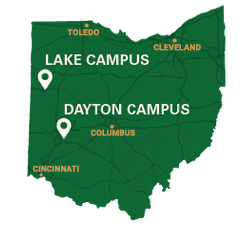Sustainability/LEED
General Privisions
Wright State University (WSU) strives to preserve the health of our campus, neighboring communities, and our environment with the institution’s ongoing commitment to sustainability. The overall impact of WSU’s built-environment supports the university’s mission and long-term success by emphasizing quality, maintainability and efficiency in the use of human and natural resources. In valuing unique campus assets like our 225 wooded acres, including the Biology Preserve in the heart of campus, WSU recognizes that long-term resilience, prosperity and sustainability is interdependent on complex, dynamic ecological systems.
Sustainability is central to the core values, priorities and decision-making that comprise the Mission of Wright State University. The 2008 Wright State University Strategic Plan states, “the necessity of preserving our planet [which] compels us to weigh the impact of our decisions, both short term and long term.” With sustainability central to our institutional values, all infrastructure, construction and renovation projects will be evaluated based on industry standard criteria set forth in the U. S. Green Building Council Leadership in Energy and Environmental Design (LEED) Life Cycle Cost Analysis. The WSU campus built-environment will demonstrate sustainable long-term planning and design by meeting or exceeding Silver LEED certification standards for both new construction and renovation of existing buildings (unless prohibited by existing conditions). All aspects of the facility lifecycle processes will be aligned with LEED standards beginning with pre-design, to site selection through construction and building operation. This includes use of durable, non-toxic building materials, furnishings and furniture obtained from regionally-sourced manufacturers that employ sustainable processes for procurement, production and transportation.
In May 2010, President Hopkins signed the Talloires Declaration, committing Wright State to a series of ten actionable initiatives, serving as a tangible sign of our continuing dedication to sustainability. This commitment means that campus facilities such as food preparation and dining services, housing, grounds, maintenance and cleaning will embody sustainability to support the academic mission and promote the health and wellness of the WSU campus community.
Energy conservation and efficiency of facilities, and sustainability practices govern how we live and work on campus as we focus on operations that include but are not limited to: optimizing the use and reuse of our currently existing buildings; reducing greenhouse gas emissions; conserving resources; promoting active, healthy lifestyle choices by supporting consumption of locally grown foods; encouraging food waste composting and use of compost to nourish garden soils; improving walkability and use of bicycles and public transportation on and near campus; preserving our natural landscapes and open spaces; minimizing use of toxic materials; increasing overall reuse, repurposing and recycling to reduce landfill waste including during construction; thereby preserving natural resources while enhancing constructed spaces on campus. Established in 1964, WSU continues to exemplify the traits of tenacity and innovation embodied in the Wright Brothers’ First in Flight heritage. Recognizing emerging technologies and innovative practices, WSU will deploy viable cutting-edge strategies to support our commitment to sustainability. True costs, derived from cost factor analysis and evaluation of life-cycle cost benefits, outweigh trendiness or novelty and override up-front expenditures when results demonstrate long-term success and durability.
At Wright State University being responsible environmental stewards means utilizing innovative approaches coupled with age-old sustainable practices to enhance WSU’s commitment to academics, research and the university mission to prepare students for success, now and into the future.

